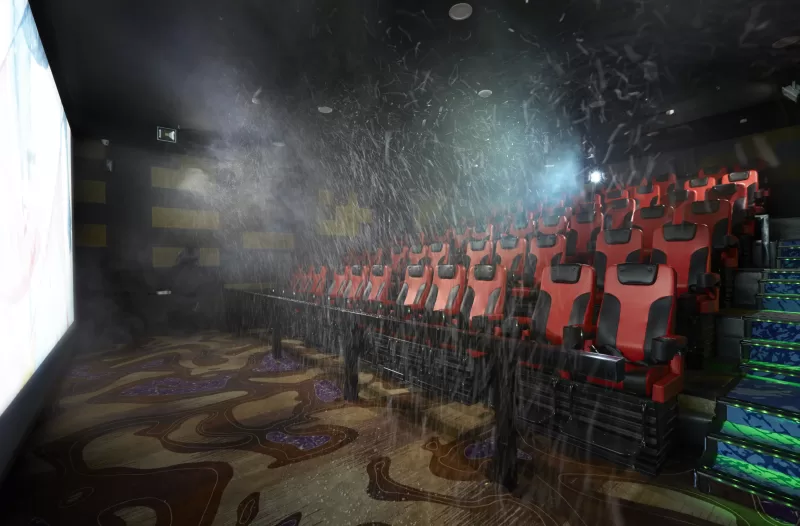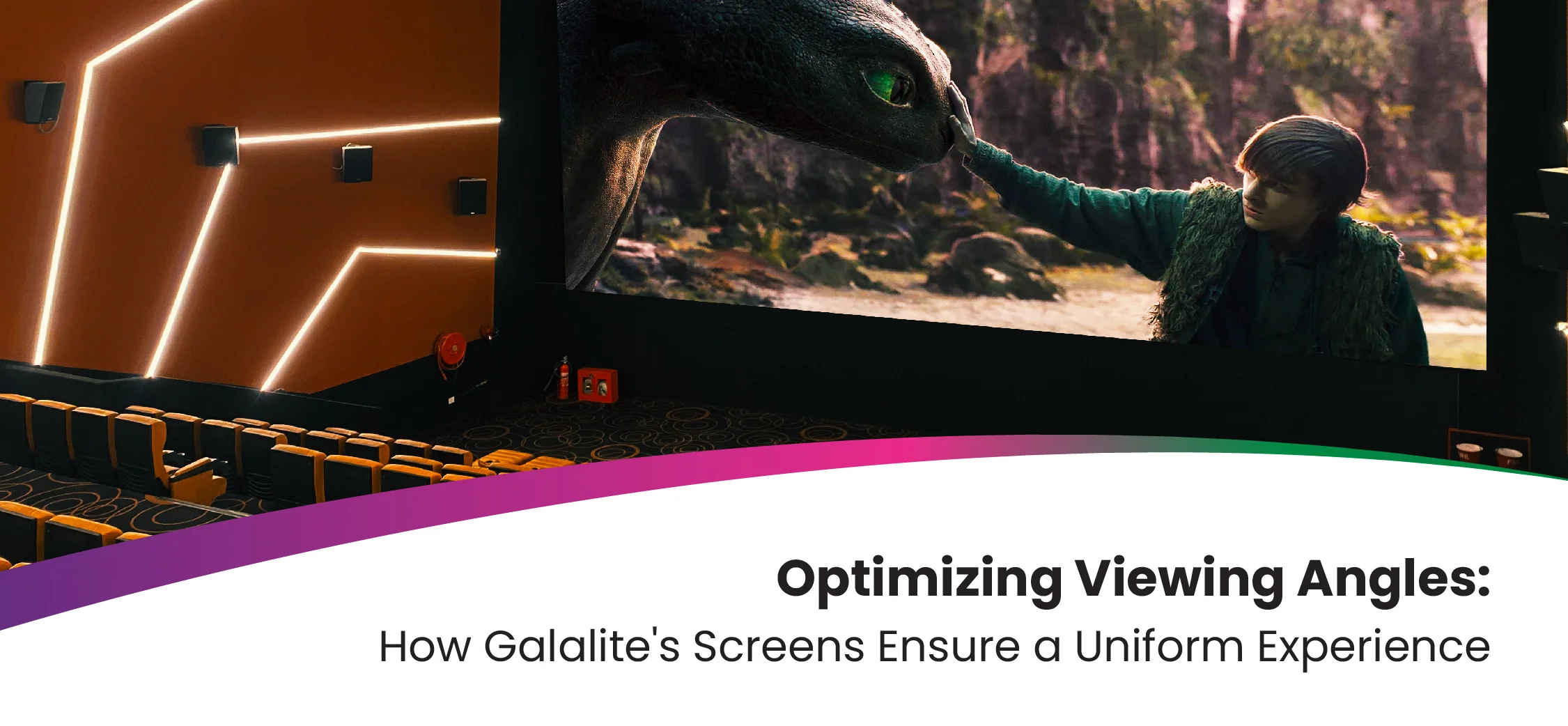
In the world of cinema, the magic extends beyond the story on screen. It lies in the coordination of light, sound, and space that captivates audiences. As we explore the physics of this cinematic experience, we’ll uncover how movie theaters, with innovations like Galalite’s Lensray Technology, elevate the journey of watching a movie in the cinema.
Interaction of Light with the Screen:
Reflection and Absorption: When light strikes a cinema screen, it can either be reflected or absorbed. The type of screen material used can affect these interactions. A high-quality screen is designed to reflect light evenly across the entire surface, ensuring uniform brightness and image quality.
Role of Projectors:
Digital vs. Film Projectors: Traditional film projectors have largely been replaced by digital projectors in modern cinemas. Digital projectors use high-intensity light sources, such as xenon lamps or laser diodes, to illuminate the screen. They offer advantages like consistent image quality and easier maintenance. (More on that here Brighter, Sharper, Better: How Laser Projection Tech is Changing Screens )
Resolution and Sharpness: The resolution of the projector, measured in pixels, directly impacts the sharpness and clarity of the projected image. Higher resolution projectors provide more detail and contribute to a more immersive viewing experience.
Brightness: Projector brightness is measured in lumens. The appropriate brightness depends on factors such as screen size, and the intended viewing environment.
Innovations in Light and Optics:
Advanced Light Sources: Laser projectors have gained popularity due to their efficiency, longevity, and ability to produce a wide color spectrum. They contribute to a more energy-efficient and sustainable cinema experience. To complement laser projectors, laser screens like Mirage XDL series by Galalite Screens can be used. It gives produces a vibrant display while minimizing speckles, providing a visually captivating experience.
Mirage XDL series maximizes black levels, resulting in improved contrast for life like and engaging visuals in unrivaled clarity and detail. Also, the excellent polarization supports Passive 3D, ensuring your cinema is always 3D-ready.
Physics of Sound Propagation in a Cinema:
Wave Propagation: Sound travels in waves. Longitudinal waves carry variations in air pressure, which our ears perceive as sound.
Speed of Sound: The speed of sound in air is approximately 343 meters per second at room temperature. This speed can vary with factors like temperature, humidity, and air pressure.
Importance of Speaker Placement and Configuration:
Channel Configuration: Modern cinema audio is typically configured as a multi-channel system, with speakers strategically placed around the auditorium. Common configurations include 5.1, 7.1, and even more advanced setups like Dolby Atmos, which incorporates overhead speakers.
Cinemas use dynamic range control to manage the difference between the softest and loudest sounds in a movie. This ensures that quiet dialogue remains audible while still delivering impactful loud moments, creating a balanced audio experience.
Innovations in Cinema Sound:
Object-Based Audio: Technologies like Dolby Atmos and DTS:X introduce object-based audio, allowing sound designers to place and move audio elements in a three-dimensional space. This enhances the sense of realism in cinematic soundscapes.
Screen technology and material science are crucial aspects of creating a visually stunning cinematic experience. The choice of screen material significantly influences how light is reflected, diffused, and ultimately perceived by the audience.
Physics of Screen Materials:
Reflectance: The reflectance of a screen material refers to its ability to reflect light. Different materials have varying levels of reflectance, and the choice depends on factors like the projector’s brightness, and desired image quality. High-quality screen materials are designed to reflect light evenly across the entire surface.
Optimal Reflectivity and Diffusivity:
Balancing Reflectivity: Achieving optimal reflectivity involves balancing brightness with color accuracy. A screen that is too reflective may lead to hotspots (bright spots) or uneven illumination. Galalite Screens ensure centre-to-edge-uniformity, that scatter light uniformly, meaning you have uniform brightness all over the screen with no hotspots.
Polarization Preservation: Some screens are designed to preserve polarization, which is essential for 3D cinema. Maintaining polarization allows viewers to experience the intended 3D effects without interference. The Mirage & Mirage XDL series by Galalite Screens are designed for 3D projection which gives excellent 3D effect, depth and a strong signal-to-noise ratio. It features Galalite’s fourth-generation silver screen technology and supports both 3D cinema and 2D cinema.
The optimal combination of reflectivity and diffusivity contributes to wider viewing angles, allowing audience members seated off-center to still experience high-quality visuals. All screens by Galalite have wide viewing angles thanks to centre-to-edge uniformity.

Image 1- Watching a 3D movie in cinema
Innovations in Screen Technology:
Galalite’s expertise shines as they pioneer advancements in screen technology. Lensray Technology, introduced by Galalite, is a revolutionary addition that significantly reduces speckle caused by RGB Laser Projectors. This breakthrough ensures that the visual canvas remains pristine, offering viewers an uninterrupted and high-quality viewing experience.
Seating arrangement and spatial perception are integral components of the cinema experience, influencing how audiences engage with the visuals and audio. This involves a combination of psychology, physics, and design principles.
Psychology and Physics of Audience Seating:
Raked Seating: Many cinemas use raked seating, where the rows of seats are elevated, providing an unobstructed view for each audience member. Raked seating also contributes to better acoustics, as it minimizes sound reflections from the back of one row to the front of the next.
Auditorium Design and Perception of Depth and Scale:
Screen Size and Placement: The size and placement of the screen are critical factors in the perception of depth and scale. The screen should be large enough to fill the audience’s field of view, creating a more enhanced experience. Proper placement ensures that the audience can perceive the intended depth in the visuals.
Innovations in Seating and Spatial Perception:
4D Cinema: 4D cinema refers to a cinematic experience that includes physical effects that may include motion seats, air blasts, water sprays, and other sensory enhancements that synchronize with the on-screen action to create a more realistic experience for the audience.

Image 2 – 4D cinema
Virtual Reality (VR) Cinemas: Emerging technologies like VR cinemas aim to provide an entirely immersive experience where audiences can feel surrounded by the content, breaking away from traditional physical auditorium constraints.
The Human Eye and Image Processing on a Large Screen:
Field of View: The human eye has a limited field of view, and it perceives the surrounding world through a series of rapid eye movements called saccades. When watching a large screen, the viewer’s eyes move to scan different areas of the image, and the brain assembles these individual glimpses into a cohesive visual experience.
Color Vision: The human eye is sensitive to a broad spectrum of colors, and filmmakers leverage this by using color grading to evoke specific moods or convey visual themes. High-quality cinema screens like Galalite Screens and projectors are designed to reproduce a wide color gamut to ensure accurate color representation.
In a nutshell, the cinematic experience is a combination of physics, technology, and innovation. Cinemas equipped with cutting-edge solutions like Galalite Screens redefine the boundaries of visual excellence. Every detail, from the quality of light to the precision of sound, plays a pivotal role in creating an unforgettable cinematic experience.
Embrace the magic, and let the physics of cinematic storytelling transport you to worlds beyond imagination. With Galalite Screens leading the way, the future of cinema promises to be an ever-evolving world of sensory delights.
FAQ’s
What is the physics behind watching a movie in a cinema?
How does projection technology impact movie visuals?
What role does sound play in the cinema experience?
How does the cinema screen affect the viewing experience?
Why is the size of the cinema screen important?
Related articles



